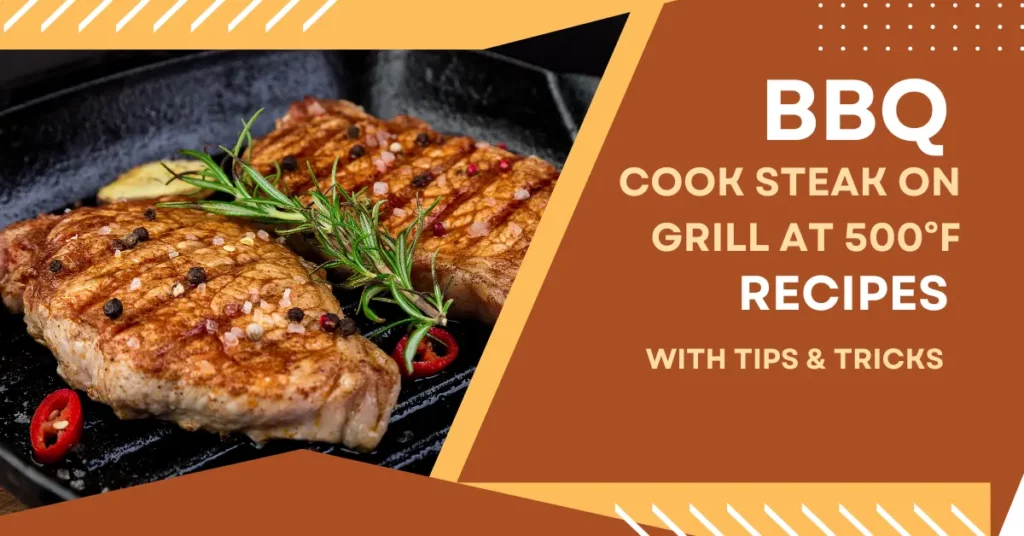This post may contain affiliate links. If you use these links to buy something we may earn a small commission. Thanks.
Grilling a steak to perfection is an art and when your grill is preheated to a blazing 500°F, you’re entering the realm of steakhouse-level searing and flavor. If you’ve ever wondered how long to cook steak on a grill at 500°F, you’re in the right place. This guide will walk you through the process step-by-step, ensuring juicy, tender, flavorful results every time.
Whether you’re a weekend griller or a passionate pitmaster, timing is everything when cooking steak at such high heat. Too long, and you risk drying it out. Too short, and it may not even reach your preferred doneness. So, let’s dive in.
Benefits of Grilling Steak at 500°F
Grilling at 500°F offers several advantages that make it a popular method for cooking steak:
1. Excellent Searing Power
High temperatures help you achieve a perfect sear, locking in juices and creating a flavorful crust. This is due to the Maillard reaction, where proteins and sugars brown and form that delicious, caramelized outer layer.
2. Faster Cooking Time
If you’re short on time but still want a delicious steak, cooking at 500°F reduces the wait dramatically compared to medium or low-heat grilling.
3. Juicier Interior
Because the steak cooks quickly at high heat, the juices remain sealed inside, resulting in a moist, tender bite.

Key Factors That Affect Cook Time
Cooking a steak at 500°F sounds straightforward, but a few critical variables determine exactly how long your steak needs to grill.
1. Steak Thickness
The thicker the cut, the longer it takes to reach the desired internal temperature. A 1-inch steak will cook much faster than a 2-inch thick-cut ribeye.
2. Type of Steak
Different cuts of steak like ribeye, strip, sirloin, filet mignon, and T-bone all behave differently on the grill. Fat content, bone presence, and muscle structure play a role in cook time and heat retention.
3. Desired Doneness
Do you like your steak rare, medium-rare, medium, or well done? Each level of doneness requires a specific internal temperature, which directly impacts cooking time.
4. Bone-In vs Boneless
Bone-in steaks often take a bit longer to cook evenly, as the bone slows down heat penetration.
5. Grill Type
Gas grills tend to provide more consistent heat. Charcoal grills, while flavorful, may have hot zones that can slightly alter cook time. Infrared grills may cook even faster due to radiant heat.
General Cooking Times at 500°F (By Thickness and Doneness)
Here’s a quick-reference chart for how long to cook your steak per side at 500°F:
| Steak Thickness | Rare (120-125°F) | Medium-Rare (130-135°F) | Medium (140-145°F) | Medium-Well (150-155°F) | Well Done (160°F+) |
|---|---|---|---|---|---|
| 1 inch | 2–3 min/side | 3–4 min/side | 4–5 min/side | 5–6 min/side | 6–7 min/side |
| 1.5 inch | 3–4 min/side | 4–5 min/side | 5–6 min/side | 6–7 min/side | 7–8 min/side |
| 2 inch | 4–5 min/side | 5–6 min/side | 6–7 min/side | 7–8 min/side | 8–9 min/side |
Note: Always use a digital meat thermometer to confirm internal temperature rather than relying solely on time.
Step-by-Step Grilling Instructions at 500°F
Step 1: Preheat Your Grill
Allow your grill to reach a full 500°F. This typically takes 10–15 minutes. A properly preheated grill ensures better searing and reduces sticking.
Step 2: Prep Your Steak
- Let your steak sit at room temperature for 20–30 minutes before grilling. This helps it cook evenly.
- Pat it dry with a paper towel for optimal searing.
- Season generously with salt, pepper, and optional dry rubs or herbs.
Step 3: Oil the Grates or the Steak
Brush the grates or your steak lightly with high smoke-point oil (like canola or avocado oil). This prevents sticking and enhances grill marks.
Step 4: Sear Each Side
Place the steak on the hot grill and cook based on the timing chart above. Flip only once using tongs — don’t press the steak down or pierce it, as this releases valuable juices.
Step 5: Monitor Temperature
Use a digital meat thermometer to ensure you hit the right internal temperature:
- Insert into the thickest part of the steak.
- Avoid touching bone or fat, which can give inaccurate readings.
Step 6: Optional – Reverse Sear
For very thick steaks (2 inches or more), consider the reverse sear method:
- Cook the steak indirectly first (lower heat).
- Then sear it at 500°F for 1–2 minutes per side for that crispy crust.
Internal Temperature Guide by Doneness
| Doneness | Internal Temp (Remove From Grill) | Final Temp (After Resting) |
|---|---|---|
| Rare | 120–125°F | 125–130°F |
| Medium-Rare | 130–135°F | 135–140°F |
| Medium | 140–145°F | 145–150°F |
| Medium-Well | 150–155°F | 155–160°F |
| Well Done | 160°F+ | 165°F+ |
Remember: Steak continues to cook slightly after removal due to carryover heat.
Resting the Steak: The Final Step
Once your steak is off the grill, let it rest for at least 5–10 minutes.
- This allows juices to redistribute throughout the meat.
- Cutting too soon will cause moisture loss and a drier texture.
- Tent it loosely with foil to retain warmth.
Pro Tips for Grilling at 500°F
- Use a two-zone grilling setup: High heat for searing, low heat zone for finishing thick cuts.
- Always let your steak come to room temperature before grilling.
- Use a timer and thermometer — don’t rely on guesswork.
- Don’t overcrowd the grill – it lowers overall temperature.
- Keep the grill lid closed for even heat retention.
Common Mistakes to Avoid
- Skipping preheating: You won’t get a good sear.
- Overcooking due to distraction: At 500°F, seconds count!
- Using a fork to flip: It punctures the meat and lets juices escape.
- Ignoring steak thickness: One-size-fits-all timing leads to uneven results.
- Not resting the steak: Patience pays off.
Best Steak Cuts for High-Heat Grilling
Some cuts naturally perform better at high temperatures due to their marbling and thickness. Here are a few favorites:
- Ribeye – Rich, juicy, and flavorful
- NY Strip – Well-balanced with great texture
- T-bone/Porterhouse – Two steaks in one: tenderloin and strip
- Sirloin – Lean but flavorful and affordable
- Filet Mignon – Very tender; sear quickly and carefully
Final Thoughts
Grilling steak at 500°F delivers results that rival your favorite steakhouse but only if you master the timing, temperature, and technique. Whether you’re cooking a quick weeknight dinner or hosting a backyard BBQ, knowing exactly how long to cook steak on the grill at 500°F is the secret to tender, juicy perfection.
Remember: use a thermometer, trust the process, and always rest your steak before slicing. With a little practice, you’ll soon be serving up steaks that make jaws drop and taste buds dance.
